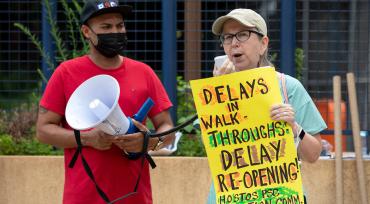How do we get back to campus after a year and a half of a pandemic that still threatens our well-being? What happens when students are afraid to return? How do faculty and staff keep everyone safe and still do their jobs?
As the fall semester approaches, AFT members are not only thinking about these questions, they are acting on them. Part of the AFT’s $5 million Back to School for All campaign, they are fanning out to promote vaccination, encourage students to re-enroll, and ensure their campuses are safe and welcoming for everyone—including Black, Indigenous, Latinx, and Asian American and Pacific Islander people, who have been hit hardest by the pandemic and continue to face discrimination in higher education.
A reason for urgency
Since the beginning of the pandemic, enrollment at colleges and universities has plummeted, and the resulting loss of revenue has meant layoffs and program cuts. Enrollment decreased by 5 percent or 727,000 students this year, after a 3.6 percent decline last year, according to the National Student Clearinghouse Research Center. At community colleges, the decline was a whopping 9.5 percent. California community college enrollment dropped 11 to 12 percent last year, and at some colleges went down 30 to 50 percent.
No one knows exactly why students are staying away, but it’s not hard to guess: Some must work, rather than re-enroll, because of pandemic-related family illness or death, or loss of income. Others may be especially vulnerable to the virus and anxious about safety. Some have simply lost momentum for attending college at all.
“It's really the end of a truly frightening year for higher education,” Doug Shapiro, who leads the research center, told National Public Radio. “There will be no easy fixes or quick bounce backs.”
Cuts and layoffs
To adjust to lower enrollments, many institutions are cutting course sections and programs and firing the faculty and staff that support them. Many suspect administrators are using the pandemic as an excuse to trim unwanted staff and programming. Either way, the net result is loss.
In the year beginning February 2020, higher education lost 650,000 jobs, according to the U.S. Department of Labor. Black, Indigenous, Latinx, and Asian American and Pacific Islander people have been disproportionately affected: They represent 25 percent of those employed in higher education, but more than half of those who lost their jobs.
Thousands of these positions disappeared when campuses shut down, including food service workers, custodians, groundskeepers and others. Staff in offices like student services, housing and financial aid were squeezed as well. Among faculty, nontenured professors and adjuncts who work from semester to semester have been most vulnerable.
At City University of New York, nearly 3,000 adjunct faculty and nonteaching staff had contracts that were not renewed—another way of saying they were laid off, as their union, the Professional Staff Congress, points out. After pressure from PSC, CUNY did rehire 1,000 of the people initially laid off; the union is continuing to fight for the rest to be reinstated.
Each position eliminated means one more person out of work. “I stand before you, with four decades of teaching experience, … without a paycheck, without health coverage, without any kind of assurance that I will be assigned teaching hours in the future, and having had to suddenly alter my plans and dreams,” Rebecca Vaughn, an adjunct instructor at LaGuardia Community College’s English Language Center in Queens, told the New York City Council as PSC lobbied for funding last December.
At State Center Community College District, a group of six colleges in and around Fresno, Calif., 514 adjunct faculty did not return for spring classes; for more than half, teacher pay is their primary income, says Keith Ford, president of the State Center Federation of Teachers. His union has set up an adjunct relief fund to help.
Nearly all 500 adjunct faculty and another 163 full-timers at the City College of San Francisco faced layoffs and course elimination this spring. Their union, AFT 2121, won all the positions back and saved classes from being cut, but had to sacrifice faculty pay. “Nobody’s happy about getting a wage cut,” AFT 2121 President Malaika Finkelstein told Mission Local. “But this is what it will take to keep our school open for our students.”
Turning it around
While affiliates are focused on layoffs and cuts, the AFT Back to School for All campaign is working to boost enrollment so there’s no need for such cuts. Related efforts include better vaccination access, funding for pandemic safety protocols and informational blitzes.
In San Francisco, AFT 2121 members are working with student artists to produce and distribute posters encouraging city residents sign up for classes at their beloved City College, and they’re already handing out college-printed promotional postcards at transit stations and other busy locations. And there’s more art going up at Community College of Philadelphia, where the Faculty and Staff Federation held a contest for artists to promote vaccinations.
Members of University Professionals of Illinois held a webinar with Dr. Ngozi Ezike, the director of the Illinois Department of Public Health, and other highly trained experts who discussed vaccine safety and efficacy. They are also reaching out to students who didn’t show up last year, urging them to re-enroll.
In New York, PSC members are participating in pre-occupancy building walkthroughs. More than 200 members have been trained by industrial hygienists to do this work alongside management representatives, but in some places the visits have been delayed—so PSC is pushing CUNY to delay the Aug. 2 start date for uninspected sites and sites that have not had time to address problems revealed during the walkthroughs. If opening is not delayed, a squad of activists is queued up to push for compliance. [Editor’s note: After press time we learned the reopening date moved to Aug. 16 to accommodate walkthroughs.]
The Faculty Association of Suffolk Community College in New York is addressing a different kind of safety, working to make the SCC experience more welcoming for Black, Indigenous, Latinx, and Asian American and Pacific Islander students. Its JEDI Institute program—that’s justice, equity, diversity and inclusion—will support workshops for faculty to examine racialized assumptions, create more inclusive course content, practice more inclusive student interactions, and lean into antiracist pedagogy and work principles.
“We as faculty need to do our due diligence,” says FASCC Secretary Cynthia Eaton, who is helping develop the program. “I truly feel it's critical that we fight long and hard on behalf of those who have been actively segregated out of the ‘Long Island quality of life’ story for decades upon decades.”
[Virginia Myers]


